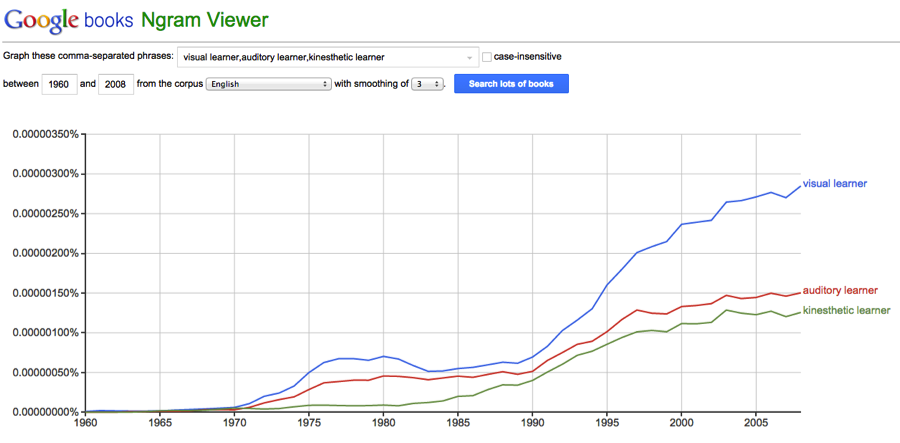
In August of 2013, I emerged from the Department of Neuroscience building at the University of Virginia armed with some controversial test results. Earlier in the month, intellectual curiosity had led me to sign up for a cognitive assessment: a battery of tests representing the best that current educational psychology research had to offer in determining my personal learning aptitudes and preferences.
The test results were clear: a small team of talented researches concluded that I was in the “very superior” range for visuo-spatial awareness and reasoning ability—the 99th percentile, in fact—while falling in the “average to below average” range for processing and recall of auditory information. Why was this result controversial?
Since the late 1960’s, the “learning styles” movement has produced no fewer than 71 different models1, each offering an accompanying assessment test that “sorts” learners into various buckets. The popular model dubbed “VAK,” introduced by Neil Fleming2 in 1992, determines whether you are a “visual,” “auditory,” or “kinesthetic” learner. Following this example, sensory preference became by far the most widespread sorting dimension for learning styles.
A quick search on Google’s Ngram Viewer catalogues the rise of the visual-auditory-kinesthetic framework starting in the late 1960’s, highlighting the explosion in recent years of the “visual learner.”

Implicit in all of these models is the notion that individual students learn differently and can benefit from personalized instruction. And while the research and our teaching experience leaves no doubt that this is true in general, we can (and should) question the best means of achieving personalization. By lumping students into categories based on sensory preference, are we denying the very individuality we aimed to honor in the first place?
In my case, the answer is a resounding yes. One longstanding conclusion of the sensory learning styles framework is that females have a strong preference for auditory processing of information, while males are visual-dominant learners. My test result showing the exact opposite flew in the face of 50 years of educational orthodoxy—and I am not alone among my female peers. If our goal is to avoid “teaching to the average,” we cannot overlook the outliers. No matter how thoughtfully reasoned out, the inherent weakness of all learning style models is that they prevent a deeper level of personalization in their unyielding aim to “sort” us out.
The research agrees: a 2009 survey3 investigating the experiential data behind the most popular learning style assessments presented the shocking conclusion that there was no factual evidence to support the claim that learning outcomes are improved when the teaching method is altered to match the student’s sensory learning style (the so-called “meshing hypothesis”). Far from rejecting the value of personalization, however, the 2009 study presented a more effective method for achieving it:
“An obvious point is that the optimal instructional method is likely to vary across disciplines.” (p. 116)4
It makes intuitive sense that we should teach art using our eyes and our hands, literature using our words, and music using our ears. The meshing hypothesis, it turns out, may be far better applied between instructional style and instructional content. Dr. Bill Cerbin, Director of the Center for Advancing Teaching and Learning at the University of Wisconsin-La Crosse, states in a 2012 interview:
“There may be evidence that indicates that there are some ways to teach some subjects that are just better than others, despite the learning styles of individuals… If you’re thinking about teaching sculpture, I’m not sure that long tracts of verbal descriptions of statues or of sculptures would be a particularly effective way for individuals to learn about works of art.”
This is an especially timely message for our upcoming Girl Day celebration on February 26 during National Engineering Week. One powerful way to get more girls (and boys) interested in science, math, and engineering is to engage them with their eyes and hands, as sight and touch are the primary senses we rely on when observing, and attempting to grasp, the workings of the world around us. After 10 years of study in STEM disciplines, and another 10 as a working female engineer, I can personally attest to the struggle of attempting to learn a visual, dynamic subject in a verbal, static way.
One of the ways Education Elements is addressing the needs of students like myself, as well as staying on top of the current educational research cited above, is by partnering with award-winning content providers like ST (Spacial-Temporal) Math, which aims to teach mathematics in a more content-aligned, visual way. For more information on how inspiring (and effective) a more visual approach can be in STEM, check out this TED talk by Matthew Peterson, the brainchild behind ST Math.
At the end of the day, to achieve true personalization in our teaching we must take care to regard individual students as exactly that—individuals. Learning style inventories speak to trends rather than individuals, and we can achieve better outcomes when we pay attention to both the way our students love to learn, and the way a subject begs to be taught!
Leave us a comment about the challenges you face, or the victories you have achieved, in making your science and math classrooms a more visually engaging place.
Erin Mastrantonio recently joined Education Elements as a Data Analytics & Visualization Specialist. Write to her at erin@edelements.com.
REFERENCES
(1) Coffield, F., Moseley, D., Hall, E., Ecclestone, K. (2004).Learning styles and pedagogy in post-16 learning. A systematic and critical review. London: Learning and Skills Research Centre.
(2) Fleming, N.D. & Mills, C. (1992). Not Another Inventory, Rather a Catalyst for Reflection. To Improve the Academy, 11, 137-155.
(3) Harold Pashler, Mark McDaniel, Doug Rohrer and Robert Bjork. "Learning Styles: Concepts and Evidence". Psychological Science in the Public Interest 9 (3): 105–119.




